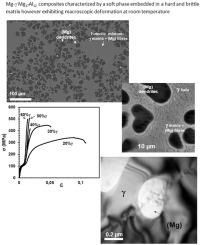Intermetallics ( IF 4.4 ) Pub Date : 2021-02-12 , DOI: 10.1016/j.intermet.2021.107127 Patricia Donnadieu , Souad Benrhaiem , Gilles Renou , Chunyang Zhang , Catherine Tassin , Jean-Jacques Blandin

|
Deformation tests at room temperature have been carried out on a series of in situ Mg-γMg17Al12 composites with volume fraction of γMg17Al12 phase varying between 20% and 60%. Regardless of the phase volume fraction, these Mg-γMg17Al12 composites that are prepared by solidification consist in magnesium-rich dendrites and a eutectic mixture. The eutectic mixture is made of magnesium fibres embedded in a matrix formed by the γMg17Al12 phase, a hard and brittle complex metallic alloy. Compression tests at room temperature have shown that a global plastic deformation is observed even though the soft phase is always enclosed in the brittle one. According to the strain-stress curve, deformation proceeds in two stages: a first stage at low stress (σ ~ 100 MPa) and low strain (Δε < 0.01) almost similar for all the composites and a second stage characterized by a strain hardening effect along with a significant deformation for composites with γ phase volume fraction smaller than 40%, whereas no or little additional deformation is observed for composites with volume fraction higher than 40% that break at high stress (~400 MPa). Microstructural observations of the deformed samples have evidenced dislocations in the γMg17Al12 matrix and their localization as pile-ups and slip bands as well as the transmission of deformation across the eutectic mixture. The plasticity of the γMg17Al12 phase and the mechanical behaviour of the Mg-γMg17Al12 composites are discussed with respect to the microstructure characteristics and to the specific atomic features of complex metallic alloy phases.
中文翻译:

镁γMg的变形17的Al 12 原位复合材料:室温机械性能,微结构和机制
在室温下变形测试已经在一系列进行原位的Mg-γMg 17层的Al 12层与γMg的体积分数的复合材料17的Al 12相20%和60%之间变化。不管相体积分数,这些镁γMg 17的Al 12由凝固制备的复合物中由富镁树突和低共熔混合物。低共熔混合物由嵌入在由γMg形成的基质镁纤维17的Al 12相,一种硬而脆的复杂金属合金。在室温下的压缩试验表明,即使软相始终被包裹在脆性相中,也观察到整体塑性变形。根据应变-应力曲线,变形分为两个阶段:第一阶段在低应力(σ〜100 MPa)和低应变(Δε<0.01)下,对于所有复合材料而言几乎都是相似的,第二阶段的特征是应变硬化效应γ相体积分数小于40%的复合材料会产生明显的变形,而体积分数高于40%的复合材料在高应力(〜400 MPa)时不会出现或几乎没有其他变形。变形样品的显微组织观察结果已在γMg证明位错17的Al 12基质及其在堆积和滑带中的定位,以及变形在整个共晶混合物中的传递。所述γMg的可塑性17的Al 12相和Mg的γMg的机械特性17的Al 12复合材料相对于所述微结构特性和复杂的金属合金相的特定原子特征的讨论。



























 京公网安备 11010802027423号
京公网安备 11010802027423号